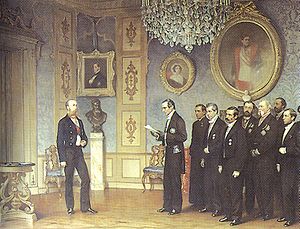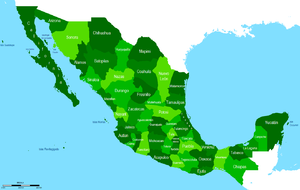- Second Mexican Empire
-
- For the earlier monarchy in Mexico in 1821-1823 see First Mexican Empire.
Mexican Empire
Imperio Mexicano← 
1864–1867  →
→

Flag Imperial Coat of arms Motto
Equidad en la Justicia
"Equity in Justice"Anthem
Himno Nacional Mexicano
"National Anthem of Mexico"Territory of the Second Mexican Empire upon establishment Capital Mexico City Language(s) Spanish Religion Roman Catholicism Government Constitutional Monarchy Emperor - 1864–1867 Maximilian I Regent - 1863–1864 Juan Almonte Legislature Congress - Upper house Senate - Lower house Chamber of Deputies History - French Intervention 1861 - Maximilian I accepts the crown April 10, 1864 - Emperor executed June 19, 1867 Currency Peso The Second Mexican Empire was the name of Mexico under the regime established from 1864 to 1867. It was created by Napoleon III of France, who attempted to use the Mexican adventure to recapture some of the grandeur of earlier Napoleonic times. The military intervention put Archduke Ferdinand Maximilian of Austria on the Mexican Throne as Maximilian I of Mexico.
Promoted and installed by the French, with some support from the Austrian and Spanish Crowns, the intervention attempted to re-create a European-style monarchical system in Mexico. The French also had support from conservative elements within Mexico, such as the Mexican nobility, who aimed to promote stability and end the constant cycle of unrest and revolution.
Contents
History
The rule of Emperor Maximiliano was blemished by constant conflict. On his arrival in 1864 with his wife, Empress Carlota of Mexico, daughter of King Léopold I of the Belgians, he found himself in the middle of a political struggle between the Conservatives that backed him and the opposing Liberals, headed by Benito Juárez. The two factions had set up parallel governments; the Conservatives in Mexico City controlling central Mexico and the Liberals in Veracruz. The Conservatives received funding from Europe, especially from Isabella II of Spain and Napoleon III of France; the Liberals found backing from United States Presidents Abraham Lincoln and Andrew Johnson, after they had finished their own Civil War in 1865.
Because some viewed Emperor Maximilian as a French puppet, he was not regarded as the legitimate leader of Mexico by them, including the U.S. government. However, many Mexicans did view him favorably and backed his government.
In 1867, Maximilian faced the firing squad at the orders of Benito Juárez, in the Cerro de las Campanas near Querétaro.
Maximilian proved to be too liberal for the conservatives, and too conservative for the liberals. He regarded Mexico as his destiny and made many contributions. Before his death, Maximilian adopted the grandsons of the first Mexican emperor, Agustín de Iturbide. Today, Maximilian von Götzen-Itúrbide is the pretender to the throne of Mexico.
Territorial division
The Empire was divided into 50 departments (departamentos):
- Acapulco
- Aguascalientes
- Álamos
- Arizona
- Autlán
- Batopilas[disambiguation needed
 ]
] - California
- Campeche
- Chiapas
- Chihuahua
- Coahuila
- Coalcomán
- Colima
- Durango
- Ejutla[disambiguation needed
 ]
]
- Nuevo León
- Oaxaca
- Puebla
- Querétaro
- Sinaloa
- Sonora
- Tabasco
- Tamaulipas
- Tancítaro
- Tehuantepec
- Teposcolula
- Tlaxcala
- Toluca
- Tula
- Tulancingo
The role of France
History of Mexico 
This article is part of a seriesPre-Columbian Mexico Spanish conquest Colonial period War of Independence First Empire First Republic War with Texas Pastry War Mexican–American War Second Federal Republic The Reform Reform War French intervention Second Empire Restored Republic The Porfiriato Revolution La decena trágica Plan of Guadalupe Tampico Affair Occupation of Veracruz Cristero War The Maximato Petroleum nationalization Mexican miracle Students of 1968 La Década Perdida 1982 economic crisis Zapatista Insurgency 1994 economic crisis Downfall of the PRI
Mexico Portal
Napoleon III had more ambitious goals in mind than merely the recovery of France's debts. Heavily influenced by his wife the Empress Eugenie, he was bent on reviving the Mexican monarchy. He wanted to place a monarch on the throne who would promote the interests of France. Prior to 1861 any interference in the affairs of Mexico by any of the European powers would have been viewed as a challenge to the United States and no one wanted to provoke a conflict with them. However in 1861 the USA was embroiled in its own bloody conflict, the American Civil War, which made the government in Washington powerless to intervene. Encouraged by the Empress Eugenie, who saw herself as the champion of the emasculated Catholic Church in Mexico, Napoleon III took advantage of the situation.
Napoleon III saw the opportunity to make France the great modernizing influence in the Western Hemisphere as well as enabling her to capture the South American markets. To give him further encouragement, there was his half brother, the Duc de Morny, who was the largest single holder of Mexican bonds.
Chronology
- 1832: Archduke Ferdinand Maximilian born on 6 July, the second son of Archduke Franz Karl and his wife Sophie in Schönbrunn Palace, Vienna.
- 1851: Begins career in the Imperial and Royal Navy with the rank of lieutenant.
- 1856: The construction of his castle of Miramar near the Adriatic port of Trieste began.
- 1857: Ferdinand Max appointed the governor-general of the northern Italian provinces of Lombardy-Venetia. On the 27th July marries the Princess Charlotte of Belgium in Brussels.
- 1859: On the 19th April relieved of his post as governor-general. War breaks out between France and Piedmont-Sardinia.
- 1861: Napoleon III suggests Maximilian as a candidate for the throne of Mexico.
- 1863: In October a Mexican delegation arrives at Miramar to offer Maximilian and Charlotte the crown. Maximilian makes his acceptance conditional on a national plebiscite in his favour.
- 1864: On the 14th April Maximilian and Charlotte leave Miramar on board the Austrian ship NOVARA to sail to Mexico.
- 1865: End of the American civil war. Pressure on France to respect the Monroe Doctrine.
- 1865: Maximilian adopts Don Agustin and Don Salvador.
- 1866: Napoleon III orders the withdrawal of French troops from Mexico. The Emperor Maximilian refuses to desert his Mexican supporters. Charlotte sails to Europe to plead for help, growing persecution mania robs her of her senses. Republican troops on the advance in Mexico.
- 1867: Maximilian and his Imperial troops besieged in the town of Querétaro. The town falls through betrayal after 72 days. On 19 June the Emperor Maximilian and two loyalist generals executed by a republican firing-squad on the Hill of the Bells.
- 1868: On the18th January the body of Maximilian laid to rest among his ancestors in the Imperial Crypt of the Capuchin Church in Vienna.
Popular culture
The 1970 film Two Mules for Sister Sara was set in Mexico during the years of the Second Mexican Empire. The two main characters, played by Clint Eastwood and Shirley MacLaine, aided a Mexican resistance force and ultimately led them to overpower a French garrison.
The 1969 film The Undefeated starring John Wayne and Rock Hudson portrays events during the French Intervention in Mexico and was also loosely based on the escape of Confederate General Sterling Price to Mexico after the American Civil War and his attempt to join with Maximilian's forces.
The 1965 film Major Dundee starring Charlton Heston and Richard Harris featured Union calvary (supplemented by Galvanized Yankees) crossing into Mexico and fighting French forces towards the end of the American Civil War.
The 1954 film Vera Cruz was also set in Mexico and has an appearance of Maximilian having a target shooting competition with Gary Cooper and Burt Lancaster's character at Chapultepec Castle. Maximilian was played by George Macready, who at 54 was twenty years older than the Emperor was in 1866.
The 1939 film Juarez featured Paul Muni as Benito Juárez, Bette Davis as Empress Carlota, and Brian Aherne as Emperor Maximilian. It was based, in part, on Bertita Harding's novel The Phantom Crown (1937).
In Mexican popular culture, there have been soap operas like "El Carruaje" (1967), plays, films, and historical novels such as Fernando del Paso's Noticias del Imperio (1987). Biographies, memoirs, and novels have been published since the 1860s, and among the most recent have been Prince Michael of Greece's The Empress of Farewells, available in various languages.
Bibliography
- Barker, Nancy N. : The Factor of 'Race' in the French Experience in Mexico, 1821-1861", in: HAHR, no. 59:1, pp. 64–80.
- Blumbeg. Arnold: The Diplomacy of the Mexican Empire, 1863-1867. Florida: Krueger, 1987.
- Corti, Egon Caesar: Maximilian and Charlotte of Mexico, translated from the German by Catherine Alison Phillips. 2 Volumes. New York: Knopf, 1928.
- Pani, Erika: "Dreaming of a Mexican Empire: The Political Projects of the 'Imperialist'", in: HAHR, no. 65:1, pp. 19–49.
See also
- First Mexican Empire
- Pretenders to the Imperial Throne of Mexico
- Mexican Imperial Orders
- Imperial Crown of Mexico
- List of Emperors of Mexico
- French intervention in Mexico
- House of Habsburg-Iturbide
External links
 Media related to Second Mexican Empire at Wikimedia Commons
Media related to Second Mexican Empire at Wikimedia Commons- Mexico: the French intervention and the 2nd Empire, 1862-1867.
- Imperial House of Mexico
- Mexican Empire
Monarchies in the Americas Current Indigenous monarchiesSettled monarchiesFormer Indigenous monarchiesAraucania and Patagonia · Aztec · Brazil · Haiti (1804-1806) · Haiti (1811-1820) · Haiti (1849-1859) · Inca · Maya · Mexico (1822-1823) · Mexico (1864-1867) · Miskito · TaínoColonial monarchiesRelated List of monarchs in the Americas · List of the last monarchs in the AmericasCategories:- Former monarchies of North America
- Former countries in North America
- Former empires
- States and territories established in 1864
- States and territories disestablished in 1867
- History of Mexico
- French intervention in Mexico
- Independent Mexico
- Mexican monarchy
- Mexican Empire
- 19th-century colonization of the Americas
- Nobility of the Americas
- 1867 disestablishments
- French colonization of the Americas
- French colonial empire
- 19th century in Mexico
Wikimedia Foundation. 2010.



